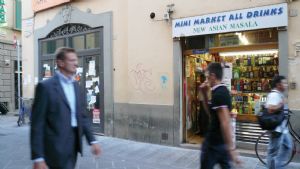Make believe for a moment that you’re the Medici’s favourite architect Bartolomeo Michelozzo. The year is 1444, and Cosimo the Elder has asked you to design him a new town palace.
‘We,’ says Cosimo, ‘will have our courtyard with columns, arches, archivolts, roundels in the frieze, the works!’
You head straight for the drawing table, armed with paper, stylus, compass, straightedge, pen and ink. You marshal your thoughts, and after a while you begin to draw one side of the courtyard. Four columns, three arches, archivolts curving over the arches like eyebrows, and higher up a frieze with big roundels. It looks good. You show it to Cosimo. He nods.
‘We,’ says Cosimo, ‘will have four sides exactly like that.’
Work begins. Everything goes smoothly until the day the workmen install the archivolts. The ones in the corners look strange. You scratch your head and ask what happened. Why do the archivolts merge higher up over the corner columns than elsewhere?
If you, Michelozzo, had listened to your compatriot Leon Battista Alberti, who was composing his Ten Books of Architecture just when you were building Palazzo Medici, you would have known that columns are meant to carry a straight architrave, not a curved arch. You would have known that, properly speaking, an arch is a round-headed opening cut out of the wall and therefore needs to rest on square pillars. But no, your loyalty went to Brunelleschi, and you followed the motif that he popularized in his buildings, namely an arch on round columns. And when you turned the courtyard corner with an arch on columns, you lost part of the wall surface needed to com-plete the arch. To use the analogy of sewing, you joined the two sides forgetting to calculate the seam allowance.
Probably the first 15th-century architect to solve this turning-the-corner problem was Luciano da Laurana, who between 1466 and 1472 designed Federigo da Montefeltro’s palace in Urbino. Laurana placed L-shaped piers at the four corners of the courtyard portico. He attached half-columns to the two ends of the corner piers and tall pilasters to their courtyard face. The half-columns make it possible for the arches in the corners of the portico to be fully displayed, and the pilasters give visual support to the horizontal frieze running around the courtyard, while at the same time masking the bulk of the pier.
By the late 15th century most Florentine architects were familiar with Alberti’s rules for building in the classical style. Giuliano da Sangallo followed Alberti almost to the letter when, in 1491, he designed the cloister of S. Maria Maddalena dei Pazzi. Sangallo used Ionic columns to carry an architrave on all four sides except on axis with the entrances from the street and into the church, where he placed arches supported on square pillars. In the corners he grouped three square pillars to form an L-shaped pier; the architrave above turns 90 degrees without any interruption of its lines. Wander over to Borgo Pinti 58 and take a look. The cloister, like the church, is open to the public mornings and afternoons. It’s a peaceful and protected place, where you can sit and read or just admire the genius of the Renais-sance architect.
The issue of corners is not restricted to courtyards. The façades of buildings also have corners; that is, sides. A façade requires visual reinforcement at right and left to contain the expanse of wall, which otherwise will seem to creep away. This concept was not new to the Renaissance. At Orsanmichele, built in the 14th century, you can still make out (though they’re largely worn away by the weather) thin colonettes on all four corners running up the height of the building. The same feature appears on the ground floor of the medieval Palazzo di Parte Guelfa, at the corner of via Capaccio and via delle Terme. But when Brunelleschi was hired to add the upper storey (unfinished) of the palace in the 1430s, he daringly chose colossal pilaster strips to mark the corners. However, columns at building corners remained popular for a long time—a late 16th-century example can be seen at the corner of via Capponi and via Giusti, on Federico Zuccaro’s house, which during 1519-30 had belonged to Andrea del Sarto.
In 17th-century Rome, Francesco Borromini, the antithesis of his contemporary Gianlorenzo Bernini, threw the rules of classical architecture out of the window. Borromini’s fantasy was boundless, and corners stoked the fires of his imagination. In the rectangular sacristy of S. Carlo alle Quattro Fontane, for instance, he rounded the corners on the vaulted ceiling and wedged a winged cherub’s head beneath the cornice to transition the ceiling’s curve into the 90-degree angle of the wall. His façades, too, are unorthodox. Look at the Collegio di Propaganda Fide, near the Spanish Steps, and you’ll see that he ends the façade with pilasters at right and left. But the way in which he angles the pilasters visually defeats their purpose, and the façade appears to slip away with all the ease of a wet bar of soap.







